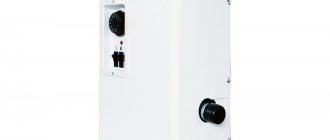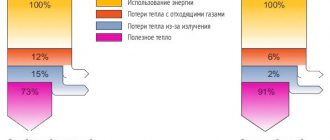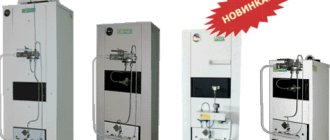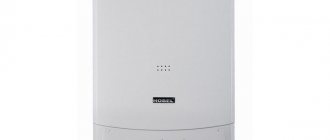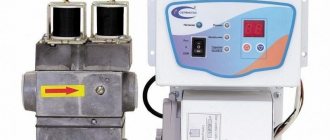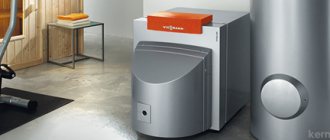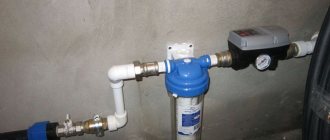Inductive-conductive electric heaters (sometimes, for simplicity, they are called induction or vortex) appeared on the heating equipment market in the 90s of the last century and since then have significantly displaced the most common heating element and electrode boilers at that time. The balance of power has changed noticeably since then. Induction heaters have gained a share of about 30%, and this share continues to increase. Previously, we already looked at what the fundamental difference between these types of heaters is (here), but now we have to understand in more detail what is the reason for the success of induction heaters, because they are more expensive than their heating element counterparts. And the reason is economics. This is what we will count today.
What is more important: acquisition cost or ownership cost?
Unlike countries with long-standing market traditions, in Russia the practice of calculating the full costs of purchasing and operating equipment over its entire service life is still not widespread. To some extent, this is due to economic uncertainty and short planning horizons at domestic enterprises. Most companies live for today, limiting themselves to plans for the next financial year. Therefore, the main criterion when choosing equipment is often the cost of its acquisition. The rest of the consumer properties of the product take a secondary role: “so what if this heater works 10 times longer? Who knows what will happen to us in a year? Maybe we'll go broke or I won't work here. Why overpay?!” Unfortunately, such “argumentation” often comes up when issues of allocating funds for this or that rather expensive equipment are discussed. As a result, poor or short-sighted decisions are made.
►See Equipment for autonomous heating in our catalog
In countries with developed economies, such questions cannot arise in principle, especially in relation to equipment on which the life of an enterprise depends. To be fair, it should be noted that many of our specialists and managers practice a balanced approach in their work: not only the purchase price is taken into account, but also those costs that will arise during operation over a long period of time (ideally, during the entire service life equipment). The most prudent and far-sighted also calculate the risks associated with ownership and operation - this is a sign of their highest professionalism. Our article can help such specialists.
Manufacturers of electric heating equipment
The domestic market offers products from various manufacturers. Not only foreign but also Russian companies lead the list.
Among the most popular are boilers from companies:
- Dacon (Czech Republic) its model range consists of 30 modifications of devices with power from 4 to 60 kW, while boilers up to 12 kW can be connected to a single- and three-phase network. Some of the samples, for example PTE L, have quiet running contactors, a circulation pump, a safety valve and an expansion tank.
- Kospel (Poland) - the company's products are single-circuit devices, as well as electric electrode boilers with multi-stage power phases in the range from 4 to 36 kW. They differ in the method of adjustment: manual and software. Basic models include: EKCO R, EKCO L 1, EKCO L.
- RusNIT (Russia) - represented by N and Country samples, they have a power range from 3 to 55 kW and are adapted to work under conditions of power surges in the network.
Payment terms
To ensure that our comparison is objective and impersonal, we will not use specific brands of equipment or specific objects in our analysis. Moreover, since the price range is extremely wide, there is no point in choosing a specific brand of product. We use average figures, which, however, are subject to comparison: prices, power and completeness of conventional products are quite comparable. 50 kW is the power of the induction heater and 50 kW of the heater (and in the latter, we will assume there are only 10 heating elements of 5 kW each).
We will compare at current average prices, without taking into account inflation and regional reference, since if you enter this data, the calculations will become much more complicated: each region has its own tariff setting, and the official inflation rate has little connection with the level of annual growth in electricity tariffs, so we will omit these factors .
We are not particularly interested in the characteristics of the heated object: if heating a room requires 50 kW of energy (or 43,000 kcal), then it does not matter which heater we choose - a heating element or an induction one - to maintain the desired temperature, they must produce the same amount of heat. We can only say that a 50 kW boiler can approximately heat a facility with a total area of about 600 m2 with a ceiling height of 3 m (responsible boiler suppliers will never recommend their equipment without assessing the facility where the equipment will operate and will always offer to make a calculation based on specific characteristics object).
The operating principle of an electrode boiler.
The physical principle here is simple - the coolant in the heating system is heated by directly passing an electric current through it. The phases of the electrical network are connected to the electrode group, and the zero is connected to the boiler body. And in a regular electric boiler, the network is connected to the heating element. To make it clearer, look at the following picture:
Heat is released due to the fact that the coolant has some resistance. In general, selecting a coolant for such boilers is a difficult task:
- Distilled water is not suitable because it does not conduct electricity.
- Water with added table salt can cause accelerated corrosion of metal parts of the system and scale deposits on the electrodes.
In the passports for such heating devices, manufacturers usually write that the boiler is guaranteed to work only with their coolant, which contains “special” corrosion inhibitors or something else. I am tormented by suspicions that this is being done in order to refuse warranty service on occasion if the consumer used some other liquid. Manufacturers recommend using propylene glycol or ethylene glycol for electrode boilers. If you are interested, you can read my article about low-freezing coolants. Now let's touch on one more issue.
Operation of electric boilers: first year
The main costs in the first year of operation will obviously be investments in the purchase and installation of equipment. Induction heaters are more expensive, but their installation and startup is no more difficult than that of a heating element boiler. Operating costs in the first year are also almost the same:
| First year | Induction heater | New heating element |
| Purchase cost | 145 000 | 40 000 |
| Safety stock 1 heating element (2 pcs.) | 0 | 4 000 |
| Heating period2, days. | 200 | 200 |
| Continuous operation time3, hour/day. | 10 | 10 |
| Energy tariff | 2,8 | 2,8 |
| Electricity costs, rub/season | 50×200×10×2,8=280 000 | 50×200×10×2,8=280 000 |
| Accident risk4 | 0 | 0 |
| Costs of consumables, rub. | 0 | 0 |
| Labor costs for operation5 | 0 | 0 |
| Total expenses at the end of the period | 145 000+280 000=425 000 | 40 000+4 000+280 000=324 000 |
1It is not necessary to create a stock of replacement elements, but this threatens, in the event of an emergency failure of the heating element, with a reduction in the design power of the equipment, therefore most operators of heating element boilers create a stock of heating elements. And they do it right!
2In Russia there are different climatic zones, and accordingly, the duration of the heating season is different - from 148 days (in Maykop) to 311 (in Anadyr). We use an average figure of 200 days (approximately the latitude of Lipetsk or Tambov).
3If the heater operates continuously during the season, then the equipment is not selected correctly. Typically, equipment is selected in such a way as to work, on average, for 8-10 hours a day
4An accident is considered to be the failure of the heating element, or a decrease in its power by more than 50%. The service life of the heating element is about 5,000 hours. However, there is a possibility that it will last less or longer than expected. We will not consider the “less” option: let’s say that neither the manufacturer of the heating element boiler nor the manufacturer of the induction boiler allowed the defect. And in the first year (2,000 hours of operation) not a single heating element burned out.
5It is absolutely impossible to do without labor costs: an energy specialist, one way or another, must carry out preventive maintenance and monitor the operation of the equipment, however, since there were no equipment failures, we will assume that the operating costs in the first year for the two types of electric boilers are approximately equal and will not take them into account.
As a result, the first year of operation ended with a convincing superiority of the shadow electric cat. The costs for it, taking into account the purchase of equipment, are almost a quarter lower. Can we celebrate the victory? It's a bit early. The equipment was purchased for more than one season - we’ll see what happens next.
Operation of electric boilers: second year
It’s not very obvious yet, but changes are starting to happen. Due to the high surface temperature of the heating elements of the heating element boiler, water boils in the boundary layer and scale is inevitably deposited. Its micron thickness is not even visible to the naked eye, but even such scale significantly reduces heat transfer, which is why heat removal decreases. The heating element heats up more, but the water, on the contrary, heats up worse. According to various estimates, the heat transfer efficiency of a heating element boiler may drop by 20% already in the first year of operation. We will try to be extremely objective and calculate this figure as equal to 10%, and only from the second year of operation. In real terms, this would mean that the heater would have to run 10% longer than a brand new heater to produce the required amount of heat energy.
An induction heater does not have such problems: the developed heat exchange area of the heat exchange device and the small temperature difference between the coolant and the heat exchanger (only 10-20°C) do not create conditions for scale deposits. In addition, natural magnetization of water occurs in an induction heater, which also increases its resistance to scale formation. There is no loss of power.
In addition, the heating elements have already worked for 4000 hours and are close to expiring their warranty period. The probability that one of the elements will require replacement during the second season is small - let’s take it equal to 10%. That is, out of ten heating elements, one will have to be replaced. The price of the heating element seems insignificant - about 2000 rubles. However, the electrician will have to work with the installation, and labor costs begin to count.
| Second year | Induction heater | New heating element |
| Heating period, days. | 200 | 200 |
| Continuous operation time, hour/day. | 10 | 11 |
| Energy tariff | 2,8 | 2,8 |
| Electricity costs, rub/season | 50×200×10×2,8=280 000 | 50×200×11×2,8=308 000 |
| Risk of accident | 0 | 10 |
| Costs of consumables, rub. | 0 | 2,000 (replacement of 1 heating element) |
| Labor costs for operation* | 0 | 190 |
| Current expenses for the period | 280 000 | 308 000+2 000+190=310 190 |
| Total expenses on a cumulative basis | 425 000+280 000=705 000 | 324 000+310 190=634 190 |
*We will assume the time to replace the heating element to be 1 hour (although in reality this figure may vary greatly). We have prudently created a stock of heating elements, so time is spent only on replacement. With an electrician's salary of 30,000 rubles/month. the cost of replacing one heating element will be only about 190 rubles. If a third-party specialist does the work, it will be about 10 times more expensive.
As you can see, at the end of the second year of operation, a heating element boiler turns out to be more profitable than an induction boiler, although not by such a convincing margin: the difference in costs is only about 10%. At the same time, the heating element heater begins to attract unnecessary attention. How much of this attention is required depends on the quality of the boiler itself, the operating conditions, and the quality of the coolant preparation. For now, we are considering a fairly favorable situation for heating elements, so that we are not accused of subjectivity and the desire to denigrate a competitive product.
Operation of electric boilers: third year
The changes that began at the end of the first year of operation are beginning to progress. There is more and more scale, although it is still not visible to the naked eye, and the system was flushed with an anti-scale agent in the summer. However, the design of the heating element is such that a drop in power occurs not only due to scale deposits, but also throughout its entire service life. Continuous operation time increased by another 15%. The warranty limit of 5000 operating hours has been exceeded. Of course, all heating elements will not burn out at once, but from this moment the countdown of days to an accident begins. The risk of failure increases significantly – up to 30%.
There are few changes in the induction electric boiler. During the summer, as a preventative measure, his heat exchanger was also washed and its energy characteristics remained unchanged.
| Third year | Induction heater | New heating element |
| Heating period, days. | 200 | 200 |
| Continuous operation time, hour/day. | 10 | 12,65 |
| Energy tariff | 2,8 | 2,8 |
| Electricity costs, rub/season | 50×200×10×2,8=280 000 | 50×200×12,65×2,8=354 200 |
| Risk of accident | 0 | 30 |
| Costs of consumables, rub. | 0 | 6,000 (replacement of 3 heating elements) |
| Labor costs for operation* | 0 | 570 |
| Current expenses for the period | 280 000 | 354 200+6 000+570=360 770 |
| Total expenses on a cumulative basis | 705 000+280 000=985 000 | 634 190+360 770=994 960 |
And so, by the end of the third heating season, the scales swung in favor of the induction boiler. Not only has the inductive-conductive unit become more cost-effective, but the shadow unit has also begun to constantly distract attention: there has been a noticeable increase in worries about it.
Operation of electric boilers: fourth year
There are no significant changes in the economy of our enterprise. We are already accustomed to the fact that during the season we need to regularly monitor the operation of the heating element boiler. They even installed a GSM control system on it. But we will not take these costs into account: after all, we agreed that we are evaluating a “clean pot” without piping.
Thermal productivity continues to decline, by 20%. It is due to the fact that the old heating elements are working. Their reliability is deceptive: they work, but they don’t provide power. As they say, it’s a pity to throw it away, but it’s more expensive to keep it.
By the end of the 4th year of operation, almost all heating elements that were once new had to be replaced. Still, some of them honestly worked 10 thousand hours – an excellent indicator.
With an induction heater you can only wipe off dust - absolutely nothing else.
| Fourth year | Induction heater | New heating element |
| Heating period, days. | 200 | 200 |
| Continuous operation time, hour/day. | 10 | 15,18 |
| Energy tariff | 2,8 | 2,8 |
| Electricity costs, rub/season | 50×200×10×2,8=280 000 | 50×200×15,18×2,8=425 040 |
| Risk of accident | 0 | 50 |
| Costs of consumables, rub. | 0 | 10,000 (replacement of 5 heating elements) |
| Labor costs for operation* | 0 | 950 |
| Current expenses for the period | 280 000 | 425 040+10 000+950=435 990 |
| Total expenses on a cumulative basis | 985 000+280 000=1 265 000 | 994 960+435 990=1 430 950 |
By the end of the fourth year of operation, the induction heater is already an absolutely confident leader in our competition, actually saving the enterprise money, not only monetary, but also time and human.
Only one thing can be said about the tensile boiler: if this continues, the electrician will only deal with it and will have to hire another one to work with the rest of the equipment...
Heating elements new boilers
Heating element electric boilers can be classified as the classic and most common type of water heaters.
Electrical energy is converted into heat using a heating element (tubular electric heater). The design of the heating element is quite simple and, at the same time, safe. The shell is made of a thin-walled metal pipe; inside there is a wire spiral made of a material with high resistivity, which heats up when an electric current passes. The free space is filled with a filler that has good dielectric properties and high thermal conductivity, for example crystalline magnesium oxide (periclase). The heat of the heated coil is transferred to the filler, and then to the shell of the heating element, which is located directly in the coolant environment and heats it. This design is absolutely safe and completely eliminates the possibility of electric shock to the consumer. The internal structure of most heating element boilers includes all the elements necessary for efficient operation:
1. A copper tank with heating elements placed inside acts as a heat exchanger. 2. The circulation pump promotes uniform heat distribution in the heating system. 3. The expansion tank compensates for excess water during heating. 4. The safety valve, air vent and pressure gauge prevent damage to the boiler when air or overpressure occurs. 5. The electronic control panel allows you to configure the boiler operation to the required mode; it is often equipped with a programmer, which allows you to adjust the boiler operating parameters depending on the time of day or day of the week. Thanks to the use of an electronic control system with the ability to program various operating modes, energy consumption can be significantly reduced. 6. The power unit ensures silent and reliable operation of the boiler. 7. The thermal switch protects the boiler from emergency overheating.
The technology for the production of heating element boilers has been perfected for decades and today they have an attractive appearance, an affordable price and are extremely convenient to use. Despite this, they have a number of disadvantages:
— scale formation on heating elements reduces boiler performance; — the heating coil burns out over time and the heating element requires replacement; — in the event of a coolant leak, the heating element also overheats and fails; — a large number of threaded, soldered and terminal connections negatively affect the reliability of the boiler.
The operation of heating element boilers is somewhat inertial: from the moment they are turned on until they reach the set parameters, it takes about 10-15 minutes.
Costs in the fifth year of operation
It seems that we have finally entered operating mode with the heating element boiler: everything has become more rhythmic and ordinary. Yes, you have to pay more for electricity, yes, you have to buy heating elements, yes, recently replaced elements begin to fail (the quality is dropping, perhaps?) and there was an unpleasant incident when a low-quality heating element broke and voltage “went” into the system. It’s good that the heater was grounded at the very beginning, otherwise troubles could not be avoided...
In general, it’s good that we only have a 50-kilowatt heater. What if it was 350? 7 times 50! How many heating elements are there, and how much would all our worries and expenses increase?
The induction heater hums slowly. After all, it is the “brother” of the transformer. It seems to be buzzing a little louder. Although, perhaps, this only seems - there is simply nothing more to complain about.
| Fifth year | Induction heater | New heating element |
| Heating period, days. | 200 | 200 |
| Continuous operation time, hour/day. | 10 | 15,18 |
| Energy tariff | 2,8 | 2,8 |
| Electricity costs, rub/season | 50×200×10×2,8=280 000 | 50×200×15,18×2,8=425 040 |
| Risk of accident | 0 | 50 |
| Costs of consumables, rub. | 0 | 10,000 (replacement of 5 heating elements) |
| Labor costs for operation* | 0 | 950 |
| Current expenses for the period | 280 000 | 425 040+10 000+950=435 990 |
| Total expenses on a cumulative basis | 1 265 000+280 000=1 545 000 | 994 960+435 990=1 430 950 |
Installation
Installing a heating element heating boiler with your own hands is not difficult; for this you do not need to have a special permit, as, for example, in the case of gas equipment.
You can install electric heating element boilers both in a separate room and in the kitchen. They do not make noise, so you will not experience any discomfort.
Heating electric boiler Kospel Ekco
Such a heating system involves the installation of the following elements:
- Directly the heating boiler itself, which heats the coolant. In addition, it can be equipped with an electronic control unit, interlocks and other devices that ensure reliable and safe operation.
- A system of piping and radiators that runs through all rooms. Its design includes: supply and return pipes, along the first the coolant moves in the direction from the boiler to the radiators, along the other it returns back and begins to warm up again.
- A circulation pump is a device that ensures constant circulation of the coolant and uses a minimum amount of energy for heating. The operation of the pump ensures that the coolant does not have time to cool in the radiators and much less energy is consumed for its secondary heating. Due to this, greater efficiency of the entire system is achieved, and the house will always be warm.
- An expansion tank is a device that compensates for the thermal expansion of water and prevents excess pressure from appearing in the system.
Do-it-yourself installation can be carried out only with strict adherence to the rules and only if you have skills in working with electricity.
In addition to the above parts, auxiliary parts such as a safety valve and shut-off valves are installed, which allow the removal of accumulated air from the pipeline and prevent the formation of plugs. All parts are assembled into a complete system, the boiler is connected to the electrical and pipeline network of the house.
Payback period for an induction heater
It makes no sense to describe all subsequent years of operation: the algorithm is already clear. Let's just say that from about the middle of the 3rd year of operation, the heating element boiler confidently breaks away from the induction boiler in terms of cost of ownership. And every year these costs will only grow.
I must say that we considered one of the most pessimistic forecasts for an induction heater - we dealt with heating element boilers as diplomatically as possible, because in fact:
- It rarely happens that a heating element lasts longer than 7,000 hours in a water heating system (we counted the operation of some heating elements for more than 10 thousand hours!).
- The power drop of a heating element boiler that has been running for some time can be up to 20% of the nominal value already in the first year of operation. We considered that in the first year there was no decline at all, and only the next year it happened. And that's only 10%.
- We considered that our staff already has the necessary energy specialist who has sufficient qualifications to quickly replace the heating element, and he does not get sick, does not go on vacation and sits, so to speak, with the heating element and a wrench in his hands, ready to rush at the first call for repairs... Does this happen to you? And if the company uses the services of a third-party specialist, the cost of “replacement” will increase at least 10 times.
- We have hardly touched upon the topic of differences in the electrical safety of boilers, but they also have a financial dimension. Electrical safety class 2 for an induction boiler (i.e., there is virtually no risk of electric shock) and electrical safety class 1 for heating elements and the risk of voltage leakage through water into the heating system (of course, there is automatic protection and grounding, but the fact remains that the risks are higher) .
The service life of a heating element boiler, despite the constant replacement of heating elements, is unlikely to exceed 10 years. An induction boiler can operate up to 100,000 hours, because at its core it is a “dry” transformer, the service life of which will end only when the impregnation of the windings of its coils finally ages and crumbles into dust. But this will happen no sooner than in 30 years (more about this in our article Service life - 30 years?!)!
What kind of electric boiler can be used to heat a private home?
Electric boilers for heating systems in private houses may differ:
- Power;
- Method of heating the coolant;
- Design features;
- Workmanship and cost.
The power of electric boilers can be from 1 to 18 kW or more.
The choice of power depends, firstly, on the purpose for which the boiler is purchased. If it will be the main source of thermal energy for the heating system, then its power is calculated in accordance with the area (volume) of the heated space and the heat loss of the external building envelope (walls, windows, doors, floor, ceiling, roof). On average, you can focus on 1 kW of boiler power per 10 m2 of house area.
If the electric boiler is planned to be used as additional heating, for example, in tandem with a boiler running on another type of fuel (gas, solid fuel), then its power may be less - 1-4 kW.
The maximum power of an electric boiler also depends on what voltage it is designed for: 220 V (single-phase current) or 380 V (three-phase). Single-phase boilers rarely have a power of more than 6-7 kW. Therefore, if you need a higher power electric boiler, you need to ensure that there is a three-phase input in the house.
Types of electric boilers according to the method of heating the coolant
Among the variety of electric boilers, according to the method of heating the coolant, three types can be distinguished:
- Heating element or electric boilers with tubular heaters;
- Electrode;
- Induction.
Each of these types of electric boilers has its own design features, advantages and disadvantages, which may affect the choice of one or another option. Therefore, in order to find out which one is better suited for heating a private home, let’s look at them in more detail.
New electric boiler
New heating element electric boiler
Electric boilers of this type have been known for a long time. To heat the coolant in them, one or more tubular heating elements (heating elements) are used - this depends on the design and power of the unit. The heating element is a metal tube with a spiral inside.
Tubular electric heating element (TEH)
The main element of a boiler of this type is a heat exchanger - a sealed, heat-insulated container with pipes for supplying and discharging water (coolant), into which a heating element - heating element - is mounted. In addition to this main element, such units are equipped with control and protective equipment that allows you to set a certain operating mode and ensure safety and long service life.
Many models of heating element electric boilers are also equipped with a circulation pump, which ensures forced movement of the coolant. In this case, there is no need to install such a pump yourself in front of the boiler.
Advantages of a heating element electric boiler:
- Relatively low cost;
- The operation of such units is safe and time-tested.
Flaws:
- The possibility of scale formation on heating elements and, as a result, a decrease in operating efficiency. To prevent this, the water used as a coolant should be as “soft” as possible (ideally distilled);
- The spiral in the heating element may burn out over time and will need to be replaced.
Electrode electric boiler
Sometimes an electric boiler of this type can be called ion, ion exchange or electrolysis, which is explained by the method used in converting electrical energy into heat. Although we are always talking about the same type of electric boilers - electrode.
Electrode electric boilers
A boiler of this type heats water (or a special liquid) - the coolant of the heating system, using its ability to heat up by flowing between two electrodes to which an alternating voltage is applied. The coolant liquid (water or special) in this case is one of the elements of the electrical circuit and must have certain properties:
- Have a strictly defined electrical conductivity, which means the presence of salt ions or hardness;
- Do not have mechanical contamination, as solid particles can lead to premature destruction of the electrodes.
Operating principle of electrode electric boilers
Such electric boilers can be either single- or three-phase, with a power from 1 to 16 kW.
Advantages:
- Simple design and small size;
- Low cost;
- Absence of heating elements and associated troubles (scale, burnout of the coil);
- A sudden or temporary lack of coolant in the system does not lead to boiler failure;
- Low sensitivity to voltage changes in the network - although the power decreases, the boiler will continue to operate;
- Low inertia - allows you to quickly heat the coolant in the heating system and quite effectively regulate operation in automatic mode.
Flaws:
- The coolant in the system must have a certain electrical conductivity, which must be controlled and maintained at the same level;
- It is not possible to use ordinary antifreeze liquid in the system, and the cost of a special one is quite high;
- During the electrolysis process, a certain amount of electrolysis gases is released;
- The power of this type of boiler depends on the temperature of the coolant - as it increases, its electrical conductivity and electrical power consumption increase;
- A fairly reliable grounding is required, since due to the specific operation of such boilers, it is not possible to use protective shutdown devices, and, therefore, the likelihood of electric shock increases;
- Difficulty in implementing stepwise power control;
- Over time, due to electrolysis, the electrodes wear out.
Induction electric boiler
Induction electric boiler
This type of boiler appeared relatively recently. Therefore, they are sometimes confused with ionic (electrode) ones. But their operation is based on a completely different method of heating the coolant - using an induction current arising in a ferromagnetic heat exchanger. For example, induction electric stoves operate on this principle.
Operating principle of an induction electric boiler
The design of such an electric boiler is a housing in which an inductor winding is placed, inside which a metal core-heat exchanger is placed. The heat exchanger can be made in the form of a labyrinth of pipes or cavities. Voltage is applied to the housing winding (inductor coil). The electromagnetic field created in this case very quickly heats up the metal core, which, in turn, transfers this heat to the heating system coolant flowing through it.
The quality and type of coolant for such a boiler do not play a big role, since microvibrations occurring in the core practically prevent the appearance of scale on the walls of the heat exchanger. As a coolant, you can use ordinary water of any hardness, antifreeze or even oil.
Due to the absence of scale, the operating efficiency of such a boiler does not decrease over time, and the service life is quite long - manufacturers promise 30 years or even more.
Advantages of an induction electric boiler:
- You can use any type of coolant;
- There is no need to replace heating elements (heating elements or electrodes);
- Operation efficiency does not decrease due to scale, since it practically does not form in the heat exchanger;
- Fast heating (about 5-7 minutes);
- Safe work;
- Long service life.
Flaws:
- The price is higher than heating elements or electrodes;
- Can only be used in a closed heating system with forced circulation;
- The weight of such an electric boiler is greater than other types - about 30-40 kg, depending on the power.
conclusions
In the worst case, when everything is not in favor of an induction electric heater, its purchase will still become more profitable after three years of operation. In practice, this deadline may come much earlier. And the higher the enterprise’s need for electric heating, and the more powerful the installations, the more profitable the purchase of induction electric boilers will be, because we based our calculations on a comparison of 50 kilowatt equipment and it’s not difficult to imagine how big the difference will be for, say, 500 -kilowatt electric boiler.
PS or answer to those who like to calculate NPV
There are specialists (usually with an economic education) who could say: “All this is nonsense! The author cites figures that are far from the real economy - he cites bare numbers, but in reality it is necessary to consider at least NPV (net present value), and then the whole picture may not be so rosy at all!”
Such arguments look ironclad. But only until we take and calculate this terrible NPV. Simply put, we can calculate how much we would earn if we had an amount of 145,000 rubles. and we could have bought an induction electric boiler, but we decided to save money and bought a shadow one for 40,000. And the saved money (105,000 rubles) would have been deposited in the bank at interest, and we would have even made money on it. Every year we would gain about 10% (in fact, most likely even less). By the end of the 5th year, we could withdraw 169,100 rubles from the bank. Those. would have received an additional 60 thousand in profit. There would be no limit to the joy until we returned to the calculations for our heaters. During the same time, we lost 321,940 rubles. - more than 5 times more than they earned. As they say, the miser pays twice. And then he pays extra.
